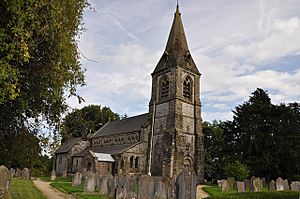St Peter's Church, Parwich facts for kids
Quick facts for kids St Peter’s Church, Parwich |
|
|---|---|

St Peter’s Church, Parwich
|
|
| 53°05′10.38″N 1°43′13.14″W / 53.0862167°N 1.7203167°W | |
| Location | Parwich |
| Country | England |
| Denomination | Church of England |
| Website | peakfive.org |
| History | |
| Dedication | St Peter |
| Architecture | |
| Heritage designation | Grade II* listed |
| Architect(s) | Henry Isaac Stevens and Frederick J Robinson |
| Groundbreaking | 1873 |
| Completed | 1874 |
| Administration | |
| Parish | Parwich |
| Deanery | Ashbourne |
| Archdeaconry | Derby |
| Diocese | Diocese of Derby |
St Peter’s Church in Parwich, Derbyshire, is a special building. It is a parish church that belongs to the Church of England. This church is also a Grade II* listed building. This means it is a very important historical building that needs to be protected.
Building St Peter's Church
The church you see today was not the first one on this spot. An older, medieval church used to stand here. It was taken down to make way for the new building.
The current church was built between 1872 and 1873. It was made from a type of stone called Coxbench stone. The architects who designed it were Henry Isaac Stevens and Frederick Josias Robinson.
A wealthy person named Sir Thomas William Evans paid for the church to be built. The church officially opened its doors on October 17, 1873. A skilled sculptor from Exeter, Harry Hems, created the carvings inside the church. The company that built the church was W.H. and J. Slater from Derby.
What is a Parish?
A parish is like a local area that a church serves. St Peter's Church in Parwich is part of a "joint parish." This means it shares its minister and some activities with other nearby churches.
The churches in this joint parish are:
- St Michael and All Angels’ Church, Alsop-en-le-Dale
- St Edmund’s Church, Fenny Bentley
- St Leonard’s Church, Thorpe
- St Mary's Church, Tissington
The Church Organ
Inside St Peter's Church, there is a beautiful pipe organ. This organ was built in 1873 by a company called Abbott and Smith. Pipe organs are large musical instruments that make sound by pushing air through many pipes. They are often used in churches for music during services. You can find more details about this specific organ on the National Pipe Organ Register.

